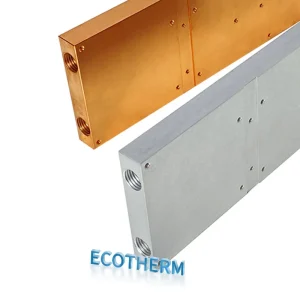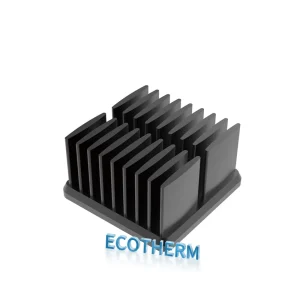The difference between a heatsink and a cooling fan
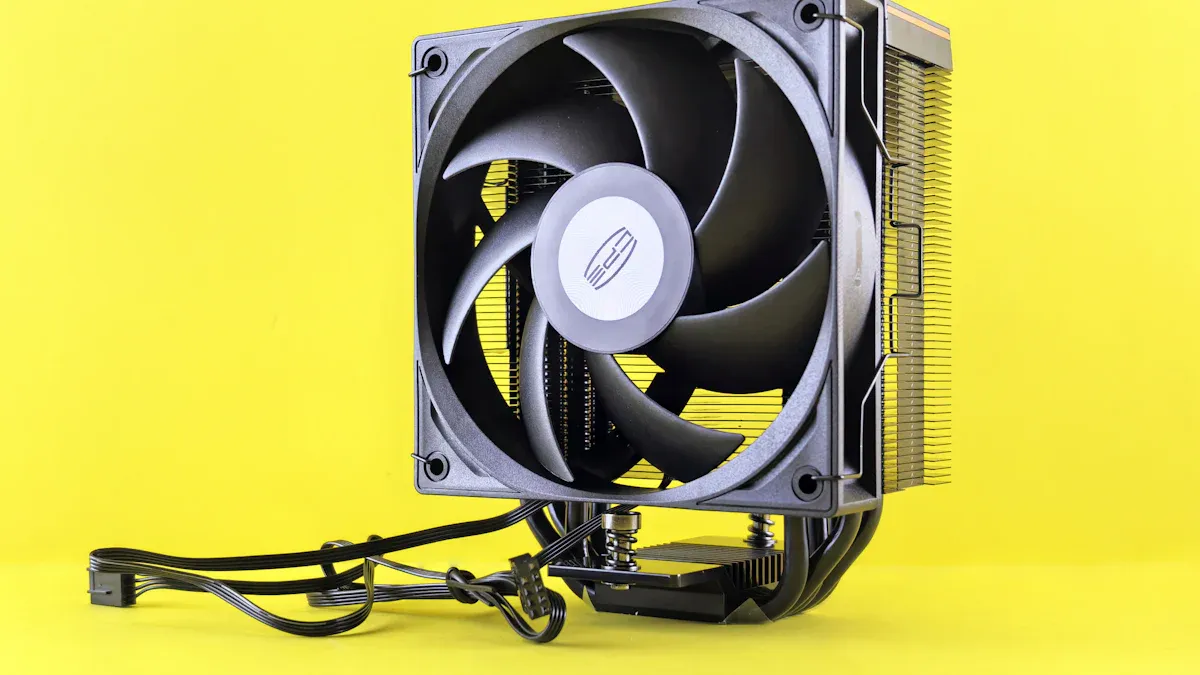
You might wonder what sets a heatsink apart from a cooling fan. A heatsink absorbs heat from your CPU and releases it into the air, working silently and without moving parts. A cooling fan creates airflow to push heat away, making it essential for high-performance computers. You often find both used together because they balance quiet operation with active cooling. Some devices rely only on a heatsink for steady heat and space-saving, while fans handle dynamic workloads and higher temperatures.
Key Takeaways
- A heatsink absorbs heat from components like CPUs and GPUs, while a cooling fan actively moves air to remove that heat.
- Heatsinks operate silently without moving parts, making them ideal for quiet environments.
- Cooling fans are essential for high-performance systems, as they provide active cooling for demanding tasks.
- Using both a heatsink and a fan together optimizes cooling efficiency, especially in gaming and workstation setups.
- Heatsinks are best for low-power devices that generate minimal heat, while fans are necessary for devices with high heat output.
- Regular maintenance, such as cleaning dust from heatsinks and fans, ensures optimal performance and longevity.
- Choosing the right cooling solution depends on your device’s heat output, space constraints, and noise preferences.
- Investing in quality cooling components can enhance your device’s performance and lifespan.
Heatsink Basics
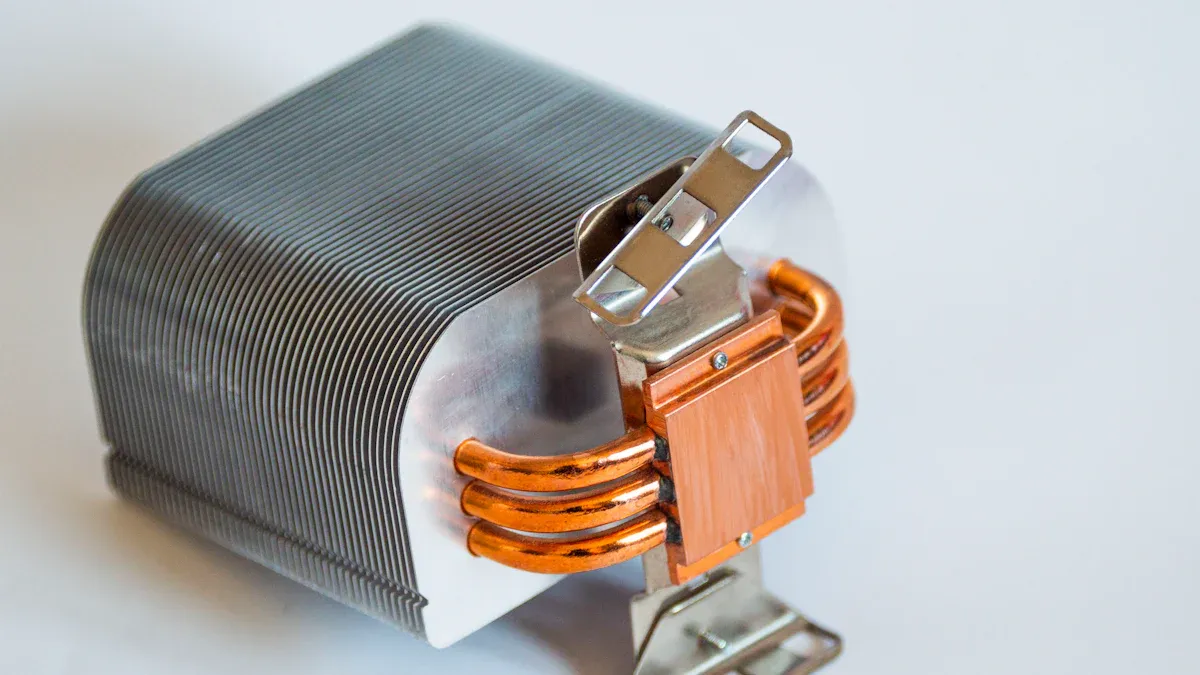
What Is a Heatsink
You often find a heatsink inside electronic devices like computers and smartphones. This component acts as a passive heat exchanger. Its main job is to draw heat away from parts such as CPUs and GPUs. By doing this, it helps prevent overheating and keeps your device running smoothly. The heatsink does not use any moving parts. Instead, it relies on its design and materials to transfer heat into the surrounding air.
How a Heatsink Works
Heat Dissipation
A heatsink works by absorbing heat from a hot component and spreading it out over a larger area. The fins on a heatsink increase its surface area. This design allows more heat to move from the metal into the air. You do not need any mechanical parts for this process. The heatsink uses natural airflow and thermal conduction to move heat away from the device.
Tip: Passive heatsinks work best for low to moderate heat loads. If you use a device for heavy tasks, you may need extra cooling, like a fan.
Materials Used
Manufacturers use materials with high thermal conductivity to make heatsinks. The most common choices are copper and aluminum. Copper moves heat very well but is heavier and more expensive. Aluminum is lighter and cheaper, but it does not conduct heat as efficiently as copper.
Here is a table showing the thermal conductivity of common heatsink materials:
| Material | Thermal Conductivity (W/(m·K)) |
|---|---|
| Diamond | 1000 |
| Silver | 429 |
| Copper | 401 |
| Gold | 310 |
| Lithium | 301 |
| Beryllium | 218 |
| Aluminium | 205 |
| Tungsten | 174 |
| Graphite | 168 |
| Pinchbeck | 159 |
| Magnesium | 156 |
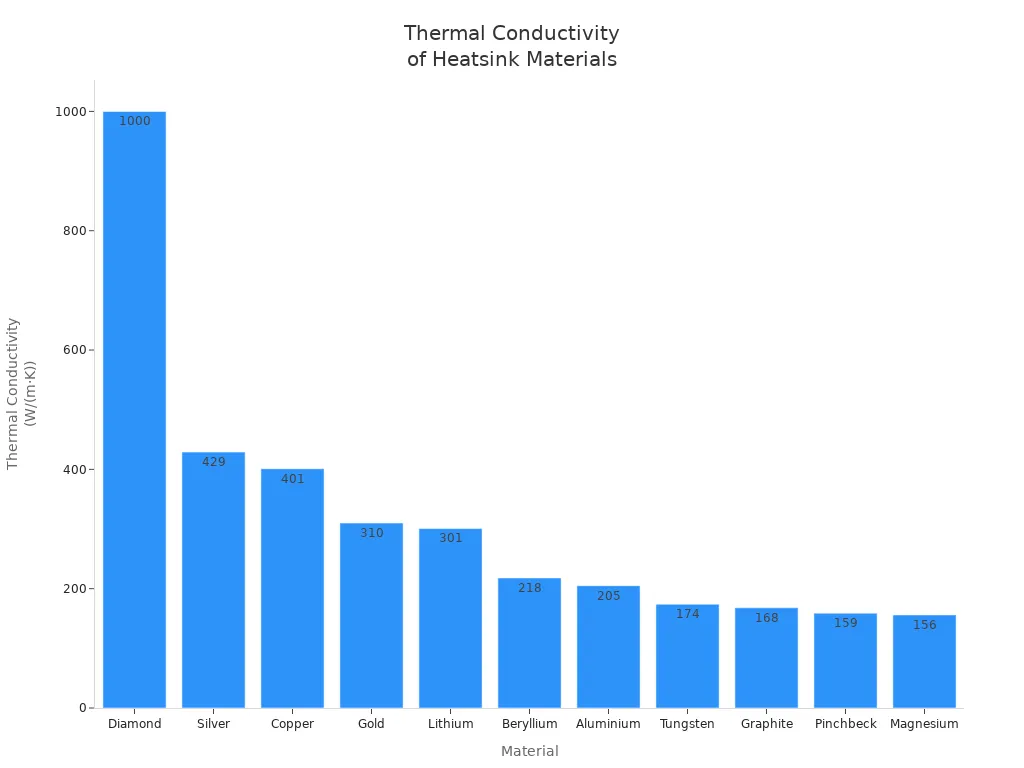
Heatsink Applications
Common Devices
You will see heatsinks in many types of electronics. Some of the most common places include:
- Computers (especially for CPUs and GPUs)
- Cell phones
- LED lighting
- Power electronics
- Consumer electronics
- Automotive and aerospace industries
Modern Features
Modern heatsinks often use special features to improve performance. Many now include heat pipes. These pipes move heat quickly from the source to the fins, spreading it out more evenly. This design helps keep temperatures lower and increases the reliability of your device. Some heatsinks use lighter materials or new shapes to fit into smaller spaces without losing cooling power.
Note: The right heatsink design can make your device last longer and work better, especially if you use it for demanding tasks.
Heatsink Pros and Cons
When you choose a cooling solution for your computer or electronic device, you need to weigh the advantages and disadvantages of using a heatsink. Understanding these points helps you make the best decision for your needs.
Pros of Using a Heatsink
- Silent Operation: You do not hear any noise from a heatsink because it has no moving parts. This makes it perfect for quiet environments like libraries or bedrooms.
- Reliability: With no fans or motors, a heatsink rarely fails. You do not have to worry about mechanical breakdowns.
- Low Maintenance: You do not need to clean or replace parts as often as you would with active cooling systems. Dust can collect on the fins, but you can easily wipe it away.
- Energy Efficiency: A heatsink does not use electricity to operate. This helps you save power, especially in devices that run all day.
- Compact Design: Many heatsinks fit into small spaces. You find them in laptops, tablets, and even smartphones.
Tip: If you want a cooling solution that works quietly and lasts a long time, a heatsink is a strong choice.
Cons of Using a Heatsink
While heatsinks offer many benefits, they also have some limitations, especially in high-performance computing environments:
- Limited Surface Area: In compact devices, you cannot use large heatsinks. Smaller surface areas mean less heat can escape.
- Height Constraints: Laptops and slim devices have little room for tall heatsinks. This limits how much heat you can remove.
- Weight and Balance: Heavy heatsinks can make portable devices bulky or unbalanced. Designers must keep them light for comfort and portability.
- Thermal Interface Challenges: Tight spaces make it hard to create efficient contact between the heatsink and the heat source. Poor contact can reduce cooling performance.
- Passive Cooling Limits: A heatsink alone may not keep up with the heat from powerful CPUs or GPUs. You might need to add a fan for extra cooling.
Here is a quick comparison table to help you see the main pros and cons:
| Pros | Cons |
|---|---|
| Silent operation | Limited surface area |
| High reliability | Height constraints |
| Low maintenance | Weight and balance issues |
| Energy efficiency | Thermal interface challenges |
| Compact design | Passive cooling limits |
Note: For low-power devices or situations where silence matters, a heatsink works well. For gaming, video editing, or other demanding tasks, you often need more cooling power.
Cooling Fan Overview
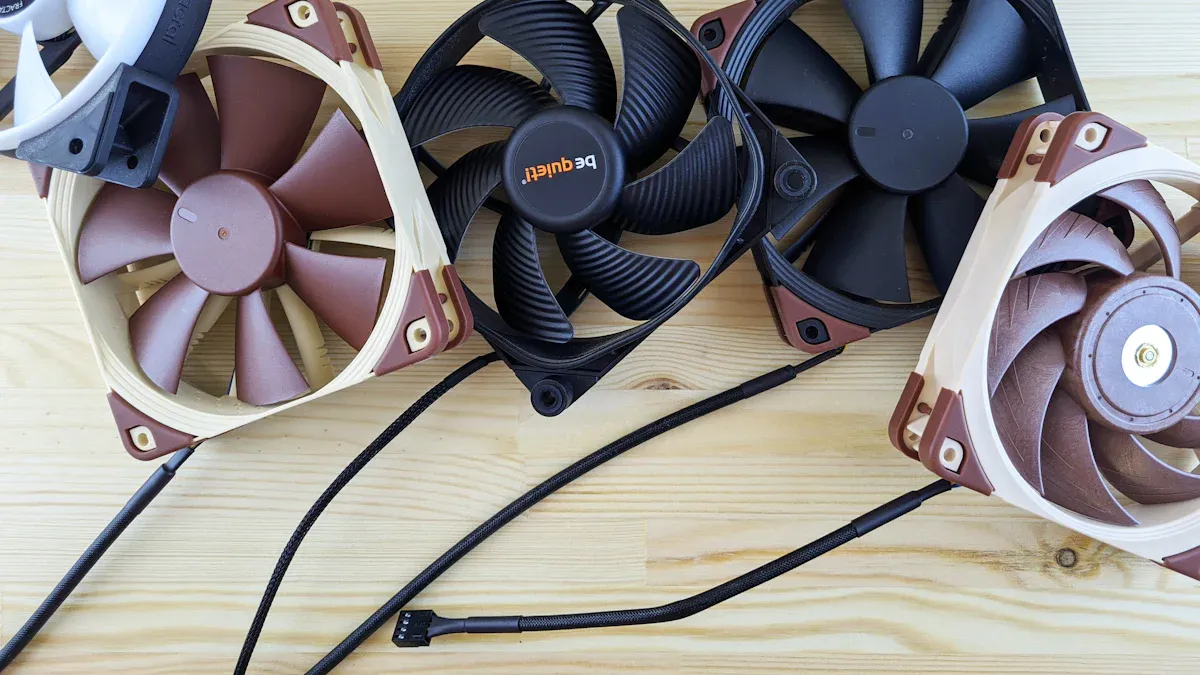
What Is a Cooling Fan
A cooling fan is an electromechanical device that helps release heat by moving air. You find cooling fans in computers, gaming consoles, and many other electronics. The fan uses a motor to spin blades, which create airflow. This airflow carries heat away from hot components, keeping your device at a safe temperature.
A cooling fan is an electromechanical device designed to assist in heat release by circulating air, which is vital for maintaining optimal operating temperatures in electrical systems.
You rely on cooling fans to prevent overheating and keep your electronics running smoothly. Fans work actively, unlike heatsinks, which only absorb and spread heat.
How a Fan Works
Airflow and Heat Removal
You see cooling fans working by forcing air over hot surfaces. The motor powers the blades, which spin and generate airflow. The housing supports the fan and directs the air where it is needed. Bearings inside the fan reduce friction, so the blades move smoothly.
- The motor powers the blades.
- Blades, or impellers, generate airflow to remove heat.
- The housing provides structural support and directs airflow.
- Bearings reduce friction for smooth operation.
Cooling fans use forced convection to move heat away from critical parts. You notice that fans draw in cool air and push out warm air. This creates a temperature difference that helps transfer heat away from your CPU, GPU, or other electronics.
Types of Fans
You can choose from different types of cooling fans for your computer. The two main types are Air Flow (AF) fans and Static Pressure (SP) fans.
- Air Flow (AF) Fans: These fans move a large volume of air with little resistance. They have fewer blades and larger gaps. You use AF fans when you need to cool open spaces inside your computer case.
- Static Pressure (SP) Fans: These fans push air through tight spaces, like radiators or heatsinks. They have more blades and smaller gaps. You use SP fans when you need to cool components with restricted airflow.
| Fan Type | Best Use Case | Blade Design | Airflow Rate |
|---|---|---|---|
| AF Fan | Open spaces | Fewer, wider blades | High at high speed |
| SP Fan | Tight spaces/radiators | More, narrow blades | High at low speed |
You need to pick the right fan type based on your cooling needs. AF fans work best in open areas, while SP fans excel in high-resistance environments.
Fan Pros and Cons
When you choose a cooling fan for your computer or electronic device, you need to weigh both the advantages and disadvantages. Cooling fans play an active role in moving air, which helps remove heat from sensitive components. This action keeps your system running safely and efficiently. However, fans also come with some trade-offs that you should consider.
Pros of Using Cooling Fans
- Active Cooling Power: Fans move air quickly, which helps remove heat from heatsinks and other hot parts. This active process keeps your CPU, GPU, and other electronics at safe temperatures, even during heavy use.
- Versatility: You can use fans in many devices, from desktop computers to gaming consoles and even power supplies. Fans come in different sizes and types, so you can find one that fits your needs.
- Improved Performance: By keeping temperatures low, fans help your device run faster and last longer. High-performance systems, such as gaming PCs, rely on fans to handle the extra heat from powerful hardware.
- Easy Replacement: If a fan stops working, you can usually replace it without much trouble. This makes maintenance simple for most users.
Tip: Fans work best when paired with a heatsink. The heatsink absorbs heat, and the fan moves it away, creating a powerful cooling combination.
Cons of Using Cooling Fans
- Noise Levels: Fans can produce noise, which ranges from a gentle hum to louder, more distracting sounds. Silent fans minimize distractions, making them ideal for quiet environments like home theaters or offices. Standard fans focus on cooling efficiency, but they may create more noise, which can affect your comfort in quieter settings.
- Wear and Tear: Fans have moving parts that can wear out over time. Bearings inside the fan determine how long it lasts and how much noise it makes as it ages.
- Power Consumption: Fans require electricity to run. This adds to your device’s overall power usage, especially if you use multiple fans or run them at high speeds.
- Dust Accumulation: Fans can pull dust into your device, which may collect on components and reduce cooling efficiency. You need to clean your fans and vents regularly to keep your system running well.
Comparing Fan Types
You will find different types of fan bearings, each with its own strengths and weaknesses. Here is a table comparing oil bearing fans and ball bearing fans:
| Aspect | Oil Bearing Fans | Ball Bearing Fans |
|---|---|---|
| Cost | Generally lower priced | Higher initial cost |
| Friction Type | Dragging friction, faster wear | Rolling friction, longer lifespan |
| Noise Levels | Can become loud over time | Generally quieter |
| Efficiency | Less efficient, more heat | More efficient, less heat |
Fan Noise and User Experience
- Silent fans help create a comfortable environment by reducing distractions.
- Standard fans provide strong cooling but may be noisy, which can bother you in quiet spaces.
- Fan noise can signal normal operation, but unusual sounds may mean a problem.
- Offices and data centers often use silent fans to keep noise levels low.
Note: You should choose a fan that matches your environment. For quiet rooms, look for silent fans. For gaming or high-performance tasks, you may need a more powerful fan, even if it is a bit louder.
By understanding the pros and cons of cooling fans, you can make a smart choice for your device. Consider your needs for performance, noise, and maintenance before you decide.
Heatsink vs. Fan
Passive vs. Active
You can separate cooling methods into two main types: passive and active. A heatsink works as a passive cooling device. It absorbs heat from your CPU and releases it into the air without using any moving parts or electricity. You do not need to worry about energy consumption because passive cooling creates zero parasitic power loss. This means your device stays efficient and quiet.
Active cooling uses a fan to move air across hot surfaces. The fan spins and pushes air, which helps remove heat faster. You need to supply power to run the fan, so active cooling systems consume energy. This small energy use can slightly reduce your system’s overall efficiency. If you care about energy savings, passive cooling offers an advantage.
Here is a quick comparison:
| Feature | Passive Cooling (Heatsink) | Active Cooling (Fan) |
|---|---|---|
| Energy Consumption | Zero parasitic power loss | Consumes energy |
| Moving Parts | None | Motor and blades |
| Noise | Silent | Audible |
Tip: You should choose passive cooling for silent operation and energy savings. Active cooling works best when you need extra heat removal.
Heat Management
You need to manage heat well to keep your computer running smoothly. A heatsink uses natural convection and radiation to move heat away from the CPU. This method works well for low to moderate heat loads. If you use your computer for basic tasks, a heatsink can keep temperatures safe.
A fan uses forced convection to push air over the heatsink or other hot parts. This process increases heat removal, especially when your CPU works hard. Fans handle high heat loads better than passive cooling alone. If you play games or edit videos, you need active cooling to prevent overheating.
Here is a table comparing heat management:
| Parameter | Heatsink | Fan |
|---|---|---|
| Cooling Method | Passive cooling | Active cooling |
| Efficiency | Good for low/moderate heat | Better for high heat loads |
| Heat Dissipation Mechanism | Natural convection + radiation | Forced convection |
Note: You should pair a heatsink with a fan for the best cooling in high-performance systems.
Design Differences
You will notice clear design differences between heatsinks and fans. A heatsink looks like a block of metal with many thin fins. These fins increase the surface area, which helps spread heat into the air. Manufacturers use materials like aluminum or copper to make heatsinks because these metals conduct heat well.
A fan has a motor, blades, and a housing. The blades spin and create airflow. The housing directs the air where it is needed. Fans come in different sizes and shapes, so you can fit them into many devices. You often see fans mounted on top of heatsinks to boost cooling.
- Heatsink: Metal fins, no moving parts, relies on thermal conduction.
- Fan: Rotating blades, powered by electricity, relies on airflow.
If you want quiet and reliable cooling, you should look for a well-designed heatsink. If you need strong cooling for demanding tasks, you should add a fan to your setup.
Power and Noise
You need to think about both power use and noise when you choose between a heatsink and a cooling fan. Heatsinks work without electricity. They do not have motors or moving parts, so they never make noise. You can use a heatsink in places where silence is important, like a library or a bedroom.
Cooling fans need power to run. The motor inside the fan uses electricity every time it spins the blades. When you turn on a fan, you will hear it. The sound level depends on how fast the fan spins and how much air it moves. Some fans are quiet, but others can get loud, especially in high-performance computers.
Here is a simple table to help you compare power and noise:
| Aspect | Cooling Fans | Heatsinks |
|---|---|---|
| Power Requirement | Needs electricity for the motor | No power needed |
| Noise Level | Can be loud, measured in decibels | Silent, no noise produced |
Tip: If you want a quiet computer, you should look for a system with a good heatsink. If you need strong cooling, you may need to accept some fan noise.
Maintenance
You should also consider how much work it takes to keep your cooling system running well. Heatsinks and fans have different needs.
Heatsinks do not have moving parts, so they rarely break. You only need to check for dust on the fins and make sure the heatsink stays in contact with the CPU. If your computer gets very hot, the heatsink can sometimes get damaged or even melt, but this is rare in normal use.
Fans need more care. You should listen for strange noises, which can mean the fan is wearing out. You may need to replace a fan if it gets damaged or if you upgrade your system. Fans can also pull dust into your computer, so you should clean them regularly.
Here is a table that shows the main maintenance needs and common issues:
| Component | Maintenance Needs | Common Issues |
|---|---|---|
| Cooling Fan | Check for noise, damage, and system fit. Clean dust often. | 1. Broken fan |
| 2. Loud noise | ||
| 3. Needs replacement during upgrades or heavy use. | ||
| Heatsink | Watch for overheating. Clean dust from fins. Ensure good contact with CPU. | 1. Overheating or melting (rare) |
| 2. May need replacement during upgrades | ||
| 3. Poor cooling can harm the processor. |
Note: Regular cleaning helps both fans and heatsinks work better. If you hear new noises or see high temperatures, check your cooling system right away.
Cost
You will find a wide range of prices for both heatsinks and cooling fans. The cost depends on the size, materials, and features. Basic air coolers and heatsinks for home computers usually cost less than advanced models for servers or gaming PCs.
For example, a simple air cooler like the SNOWMAN MC45-4-BK costs around $7 to $8. A more advanced server heatsink, such as the SNK-P0070APS4, can cost $25 to $30. Liquid coolers and high-end fans, like the DEEPCOOL LE720, may cost $38 to $40. Some coolers, like the AMD Wraith Prism RGB, offer extra features and cost about $20 to $22.
Here is a table comparing some popular options:
| Product Name | Heat Pipes / Base | TDP Rating | Price Range |
|---|---|---|---|
| SNK-P0070APS4 Server Heatsink | 5 Copper | 300W+ | $25-30 |
| DEEPCOOL LE720 Liquid Cooler | N/A | 280W | $38-40 |
| SNOWMAN MC45-4-BK Air Cooler | 4 Copper | 180W | $7.18-8 |
| 1U LGA2011 Server Active Cooler | Copper Base | 200W | $16-19.50 |
| AMD Wraith Prism RGB Cooler | Direct Contact | 125W | $20-22 |
You can also see the price differences in this chart:
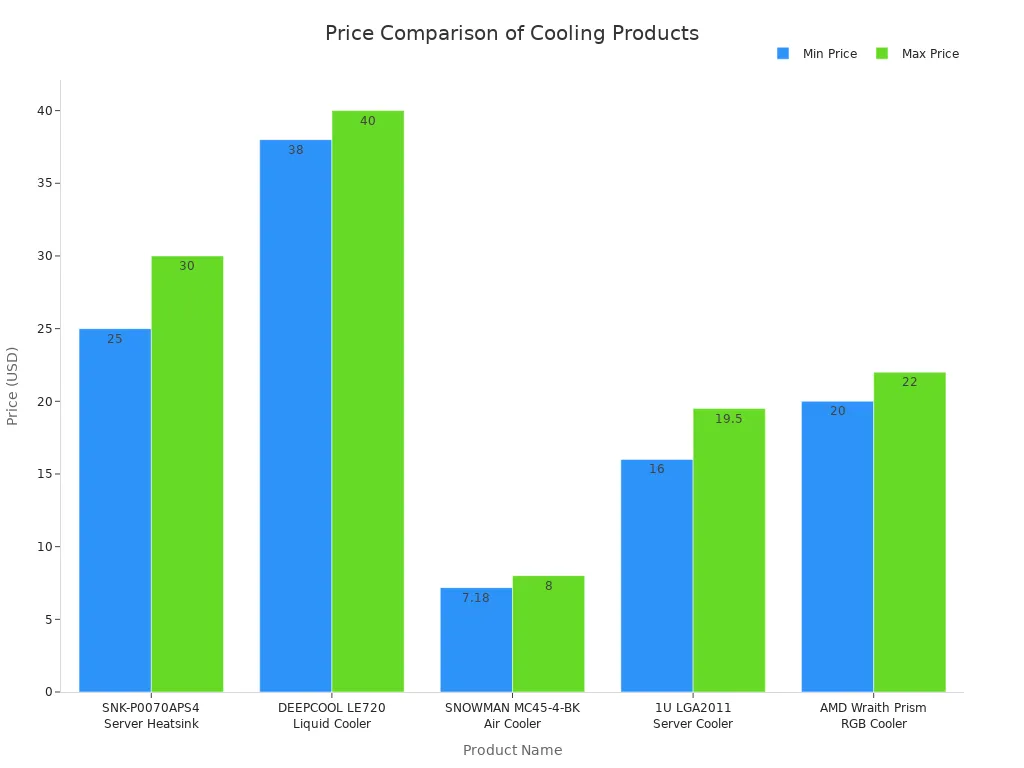
Tip: You should choose a cooling solution that fits your budget and your computer’s needs. Basic heatsinks cost less, but high-performance fans or liquid coolers may be worth the extra money for demanding tasks.
When to Use Each
Only a Heatsink
Low-Power Devices
You can use only a heatsink in devices that do not generate much heat. Devices like routers, set-top boxes, and some tablets often rely on passive cooling. These electronics have processors that work at lower speeds and do not get very hot. A heatsink absorbs and spreads the heat, keeping the device safe without extra help. You do not need a fan because the heat load stays low. This setup works well for energy-saving gadgets and small electronics.
Silent Operation
You may want a completely silent device. In this case, a heatsink is the best choice. Heatsinks have no moving parts, so they do not make any noise. You can use them in home theaters, recording studios, or bedrooms where silence matters. Many people choose passive cooling for media centers or office PCs to avoid distractions. If you value peace and quiet, a heatsink-only solution gives you reliable cooling with zero noise.
Only a Fan
Space Constraints
You sometimes face tight spaces inside your device. In these situations, using only a fan can help you cool components without bulky heatsinks. Axial cooling fans fit into small areas and provide strong airflow. Their compact design lets you place them in spots where larger cooling systems would not fit. You can see the main benefits in the table below:
| Benefit | Description |
|---|---|
| Cost-Effective and Energy Efficient | Cooling fans are cheaper to install and operate compared to refrigeration or liquid cooling systems. |
| Quick and Efficient Heat Transfer | They enhance heat transfer through forced convection, which is more effective than passive cooling. |
| Compact and Space-Saving | Their small size allows for integration into tight spaces, unlike larger cooling systems. |
You can also find that axial fans help reduce power consumption. This efficiency lowers your operational costs and keeps your device running cooler. Their streamlined structure makes them easy to add to many types of electronics, from compact desktops to networking equipment.
Temporary Cooling
You might need extra cooling for a short time. For example, you may use a fan to cool a device during a heatwave or while running a demanding task. Portable fans can provide quick relief when your system gets too warm. You can set up a fan to blow air directly onto a hot component. This method works well for temporary fixes or testing, but it is not a long-term solution for high-performance systems.
Tip: If you need a fast and flexible way to cool your device, a standalone fan can help in a pinch.
Both Together
High-Performance Systems
You should use both a heatsink and a fan in high-performance computers. Gaming PCs, workstations, and servers generate a lot of heat. A heatsink absorbs and spreads the heat, while the fan moves air across the fins to carry the heat away. This combination keeps your CPU and GPU at safe temperatures, even when you push your system hard.
- Combined heatsink and fan solutions help manage thermal behavior in powerful computers.
- They prevent thermal shutdowns and improve system reliability by optimizing airflow and heat dissipation.
- Designers use these solutions to avoid hotspots and ensure even heat distribution.
You can trust this setup to keep your system stable during long gaming sessions or heavy workloads.
Gaming and Overclocking
You need the best cooling when you play games or overclock your CPU. These activities push your hardware to its limits. A heatsink alone cannot keep up with the extra heat. Adding a fan boosts cooling power and helps maintain top performance. Many gaming PCs use large heatsinks with multiple fans to handle the intense heat. This setup lets you enjoy smooth gameplay and fast speeds without worrying about overheating.
Note: For demanding tasks like gaming and overclocking, always pair a quality heatsink with a strong fan for the best results.
Choosing the Right Solution
Assessing Needs
You need to think carefully before choosing a cooling solution for your device. Start by looking at how much heat your device produces. Devices with low-power processors, like routers or tablets, often work well with just a heatsink. If you use your computer for gaming or video editing, you need more cooling power. In these cases, you should combine a heatsink with a fan.
Consider the environment where your device operates. If your device sits in an enclosed space with poor ventilation, natural convective air cooling may not be enough. Forced-air solutions, like fans, work better in these situations. You should also check the size of your device and the available space for cooling components.
Here are the most important factors to consider:
- Heat Output: High-performance CPUs and GPUs need more cooling.
- Device Environment: Poorly ventilated enclosures require forced-air cooling.
- Space Constraints: Small devices may limit the size of heatsinks or fans.
- Noise Sensitivity: Quiet environments benefit from passive cooling.
- Budget: Advanced cooling systems cost more.
You should also think about how heat moves inside your device. Conduction works well if your device has a PCB designed for heat extraction. Convection depends on air movement, which can be limited in tight spaces. Radiation rarely helps because most systems do not have unobstructed surfaces.
Tip: Always match your cooling solution to your device’s heat output and environment. This helps you avoid overheating and keeps your system running smoothly.
Balancing Performance and Noise
You want your device to stay cool, but you may also want it to stay quiet. Heatsinks offer silent operation, making them perfect for bedrooms or offices. Fans provide stronger cooling, but they can create noise. You need to find the right balance between performance and comfort.
If you use your device for demanding tasks, you may need to accept some fan noise for better cooling. You can choose silent fans or adjust fan speeds to reduce noise. Some systems let you set fan curves, so the fan only speeds up when temperatures rise.
Here are some ways to balance performance and noise:
- Use a large heatsink to absorb more heat and reduce the need for high fan speeds.
- Select fans with low noise ratings for quiet operation.
- Place your device in a location where fan noise will not disturb you.
- Clean your cooling system regularly to keep fans running smoothly.
| Cooling Solution | Performance | Noise Level | Best Use Case |
|---|---|---|---|
| Heatsink Only | Moderate | Silent | Low-power, quiet spaces |
| Fan Only | High | Audible | Tight spaces, temporary |
| Heatsink + Fan | Very High | Adjustable | Gaming, heavy workloads |
Note: You can use fan control software to fine-tune noise and cooling. This lets you enjoy both comfort and performance.
Installation Tips
You need to install your cooling system correctly to get the best results. Follow these steps to maximize cooling efficiency:
- Choose the Right Location: Place the fan at least 3-5 feet away from walls or other objects. This improves air circulation.
- Secure the Fan: Use the correct mounting hardware to keep the fan stable.
- Connect Power Supply: Attach the fan to a suitable power source. Follow the manufacturer’s instructions.
- Check Orientation: Install the fan so it blows air in the right direction. Look for arrows on the fan casing.
- Test the Installation: Turn on your device and watch the fan. Make sure it spins smoothly and moves air as expected.
Tip: Always read the installation guide for your cooling components. Proper setup helps prevent overheating and extends the life of your device.
Common Mistakes
You may run into problems if you do not install your cooling system correctly. Here are some common mistakes and how to avoid them:
| Mistake Type | Explanation |
|---|---|
| Improper Sizing | A cooling system that is too small cannot keep temperatures down. Too large wastes energy. |
| Improper Placement | Placing fans or heatsinks in the wrong spot blocks airflow and reduces cooling efficiency. |
| Inadequate Insulation/Sealing | Poor insulation lets heat escape. Bad sealing can cause moisture problems. |
| Electrical Wiring Errors | Incorrect wiring can cause malfunctions or safety risks. Hire professionals if needed. |
| Voltage Compatibility Issues | Using the wrong voltage can damage your cooling system. Always check electrical requirements. |
You can avoid these mistakes by:
- Measuring your device’s size and heat output before buying a cooling system.
- Placing fans and heatsinks where air can flow freely.
- Checking insulation and sealing to keep heat inside the cooling path.
- Hiring licensed professionals for electrical work.
- Verifying voltage compatibility before installation.
Note: Careful planning and installation help you get the most from your cooling system. This keeps your device safe and efficient.
You now understand that heatsinks absorb and spread heat, while fans actively move air to boost cooling. Using both together gives you the best results, especially in high-performance systems. Effective cooling prevents overheating, which can degrade performance and shorten your hardware’s lifespan.
- Consistent airflow and heat management keep your system reliable.
- Overheating leads to thermal throttling and reduced lifespan.
Choose your cooling solution based on your needs. For your next build or upgrade, always match your cooling to your device’s power and workload.
FAQ
What is the main difference between a heatsink and a cooling fan?
A heatsink absorbs and spreads heat from your CPU or GPU. A cooling fan moves air to carry heat away from the heatsink. You often use both together for the best cooling results.
Can you use a heatsink without a fan?
Yes, you can use a heatsink alone in low-power devices. These devices do not generate much heat. For powerful computers, you need a fan to help remove extra heat.
Why do gaming PCs need both a heatsink and a fan?
Gaming PCs create a lot of heat. The heatsink absorbs and spreads this heat. The fan pushes air through the heatsink, removing heat quickly. This keeps your system cool during intense gaming.
How do you know if your cooling system works well?
You should check your device’s temperature using monitoring software. If temperatures stay within safe limits, your cooling system works well. Unusual noise or high temperatures mean you should check your heatsink and fan.
Do cooling fans make a lot of noise?
Some fans make noise, especially at high speeds. You can choose silent fans for quieter operation. Regular cleaning helps reduce noise caused by dust buildup.
What materials work best for heatsinks?
Copper and aluminum work best for heatsinks. Copper conducts heat better, but aluminum is lighter and less expensive. Many heatsinks use both materials for better performance.
How often should you clean your heatsink and fan?
You should clean your heatsink and fan every few months. Dust can block airflow and reduce cooling. Use a soft brush or compressed air to remove dust safely.
Can a cooling fan lower the temperature without a heatsink?
A fan alone can move air and provide some cooling. However, without a heatsink, it cannot absorb and spread heat well. For best results, use both together.

